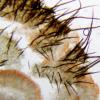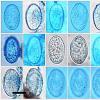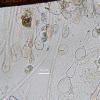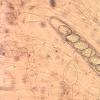
15-12-2025 15:48
 Danny Newman
Danny Newman
Melanospora cf. lagenaria on old, rotting, fallen

15-12-2025 15:54
 Johan Boonefaes
Johan Boonefaes
Unknown anamorph found on the ground in coastal sa

15-12-2025 21:11
 Hardware Tony
Hardware Tony
Small clavate hairs, negative croziers and IKI bb

15-12-2025 07:09
 Danny Newman
Danny Newman
indet. Rutstroemiaceae sp. on unk. fallen leavesMc

15-12-2025 07:05
 Danny Newman
Danny Newman
Pseudosclerococcum golindoi (det: Zotto)near Cosb

15-12-2025 11:49
 Danny Newman
Danny Newman
ITS sequences from the following two collections B

15-12-2025 12:34
 Danny Newman
Danny Newman
indet. Rhytismataceae on oak leafnear Purchase Roa

09-12-2025 12:06
 Andgelo Mombert
Andgelo Mombert
Bonjour,Je recherche l'article concernant Hypobryo
This collection of Scutellinia were collected in Norway, on 07/28/17, on bark of a branch, probably of birch, semisumergida in a stream. The apothecia measures 3-8 mm.
Ellipsoidal ascospores with verrucous decoration very little visible in the spore contour, without forming crests and of length< 5 Âĩm
(18.5) 20.3 - 23.5 (24.9) Ã (11.2) 11.9 - 13.6 (14.5)Â Âĩm
Q = (1.5) 1.6 - 1.8 (2); N = 25
Me = 21.7 Ã 12.6 Âĩm; Qe = 1.7
Ascas inamiloidesÂ
(234.3) 237.3 - 298.1 (308) Ã (14.7) 15.2 - 20.3 (23) Âĩm
Hairs of the margin quite long and with the pale apex and frequently bifurcated base, of
(289.1) 387.3 - 1394.2 (1531.1) x (17.7) 23.8 - 32.3 (33.8)Â Âĩm
Much shorter external face hairs
Often bifurcated at the base (226.4) 229.8 - 272 (276.5) Ã (6.8) 9 - 10.9 (12.1)Â Âĩm

I'm not sure, if all the measured spores are mature. Mature (ejected) spores I only saw completely filled with small lipid guttules. That two groups pattern (as in some spores in your photo, e.g. bottom left corner) I saw only when they were still in ascus.Â
I would exclude subhirtella, the hairs are about twice so long here. It is probably something from the long-haired group S. crinita, S. scutellata and S. pilati, I think the hair base is wide and short with many roots, the roots sometimes branching.
If the ornamentation is visible on the spore outline with 40x objective, it should exclude S. pilati (which has only up to 0,3-0,4 um high ornamentation, visible on the outline only with immersion). If you don't have sporeprint, you can try to make a preparate from a little piece from the middle of the hymenium - the spores should be most mature there. I wouldn't be surprised if it's S. crinita.Â
Viktorie
Measures of ascospores are taken on those that were expelled from the ascas, and only the second spore above contained lipid gut evident from all spores measured, I suppose because it was immature and had not yet developed sporal ornamentation. I believe that mature spores are covered with short warts, barely visible in the contour.
The length of the hairs of the margin is (123) 230.6 - 1338.9 (1539.5) ?m
N = 60, however the mean is 561.8 ?m, and only a few of them> 800 ?m
The length of the receptacle hairs is (181.6) 189.4 - 370.9 (432.8) ?m
N = 17, and the mean of 281.3 ?m.
The root is usually bifurcated, although in the hairs of greater length is something more branched.

Mal
The spore length of my collection is more similar to S.crinita.
Mal
Ps Benats key has S crinita with a maximum spore size of 19.5 x 12

I transcribe the text of Rene's work.
Mal and Viktorie, thank you very much for your information. Greetings.
 CONTRIBUTION A L'ETUDE DES DISCOMYCETES. (1994) RenÃĐ Dougoud. Documents Mycologique, tome XXIV, fascicule 93. pp.9-10
"DONADINI (1980 a) dÃĐcrit pour le genre Peziza (Dill) Lin., l'aptitude des cellules de la chair et des paraphyses à ÃĐvoluer de la forme cylindrique à celle moniliforme à piriforme globuleuse, et il nomme fortoulisme cette ÃĐvolution (Pl. VI, fig. 4). Il distingue deux types:
a) Le fortoulisme gÃĐnotypique, caractÃĐrisÃĐ par P. varia Hedwig : Fr. et dans une moindre mesure par P. vesiculosa Bulliard :Fr., aux paraphyses peu moniliformes dans la jeunesse, mais le devenant toutes vers la maturitÃĐ, en particulier à la base.
b) Le fortoulisme phÃĐnotypique de P. nivalis (Heim & Remy) Moser et de sa variÃĐtÃĐ fortoulii (Donadini & Neville) Donadini est, pour l'essentiel, le rÃĐsultat de conditions ÃĐcologiques particuliÃĻres (humiditÃĐ trÃĻs ÃĐlevÃĐe du substrat et variation de la tempÃĐrature)."
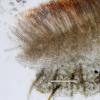

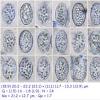
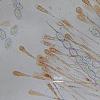
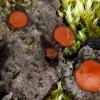
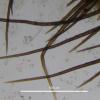
 0.MACRO.2-0001.JPG
0.MACRO.2-0001.JPG